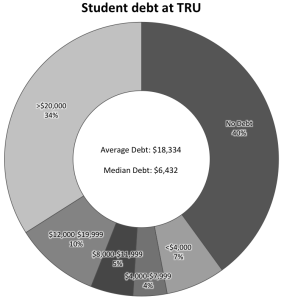Devan C. Tasa, News Editor Ω
A survey released by a consortium of 37 universities indicates when TRU students graduate, they generally either don’t owe any money or owe more than $20,000.
Of the 136 TRU class of 2012 graduates that answered the question about accumulated debt in the Canadian University Survey Consortium’s (CUSC) 2012 survey of graduating students, 40 per cent reported having no debt while 34 per cent reported owing more than $20,000.
That’s on par with the answer provided by 15,109 graduates of the 37 universities, in which 41 per cent had no debt and 33 per cent owed more than $20,000.
The average debt owed by those graduating at TRU is $18,334, which is $3,881 higher than the average of the 37 universities.
“Average student debt at TRU is almost $4,000 more than the Canadian average,” stated a TRUSU ad in the Nov. 21 edition of The Omega, which cited the survey as its source.
However, the 37 universities do not encompass the entire Canadian university sector. The most up to date figures can be found in Statistics Canada’s 2007 National Graduates Survey, which examined the class of 2005. Students graduating that year with a bachelor’s degree owed an average of $19,500.
Dustin McInytre, TRUSU’s president, said the results of the CUSC survey were not a surprise to the students union.
“Student debt is more of a symptom than the problem. The problem, we believe, is the cost,” he said. “We’re concerned that students are taking more and more debt due to an increase in tuition fees and a lack of provincial funding for post-secondary education.
“What we need is a commitment for our institution to freeze tuition fees at the May 2013 board of governors meeting,” adding the students union wanted to work with the university to increase provincial funding.
While the average student debt at TRU was higher than the 37 universities, the median student debt was lower. TRU students had a median debt of $6,432, equating to $568 lower than the median of the 37 universities.
A median, like an average, is a way to generalize a set of numbers. For example, if there was a set of numbers containing 1, 2, 3, 5 and 100, the average, calculated by adding the sum of the numbers divided by the amount of numbers, would be 22.2 while the median, calculated by selecting the number in the middle, would be 3.
This may indicate the number of average student debt is skewed, with a few students surveyed owing a large amount of student debt. The survey reported $600,000 as being the largest individual debt owed by the student interviewed.
McInytre said comparing the average and the median may be missing the point.
“It’s not about inflation, or the median or average debt, it’s about the fact that the cost is becoming so exorbitant at TRU,” he said. “Let’s not talk about the student debt, let’s talk about funding and the cost of TRU. That’s what’s important.”
The graduating survey is conducted on behalf of the CUSC every three years. Along with student debt, it measures student satisfaction, experiences and future plans.
